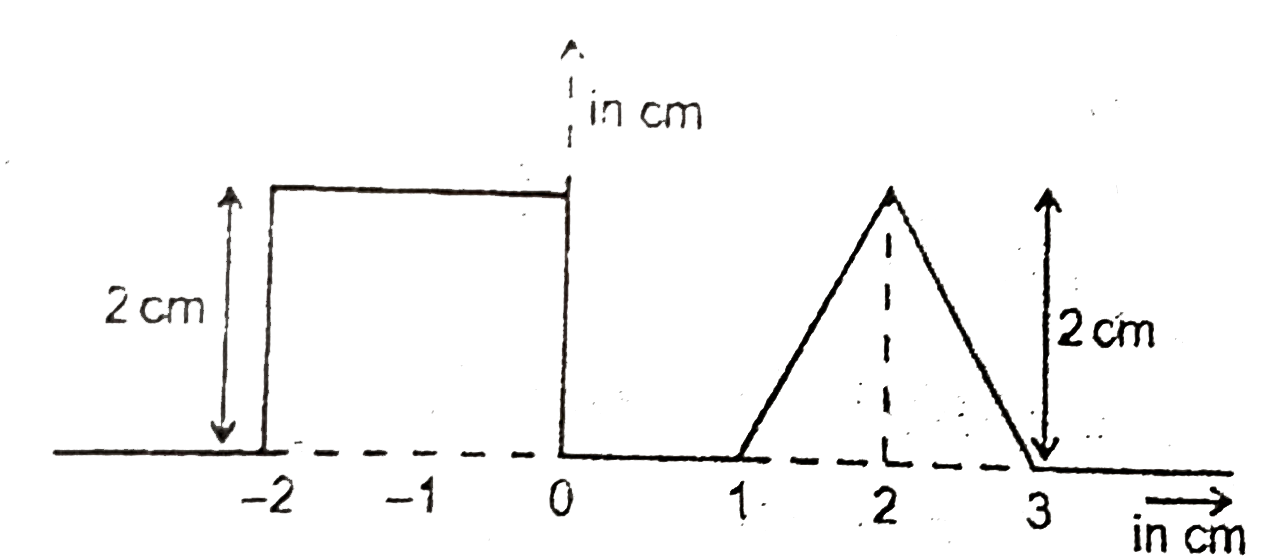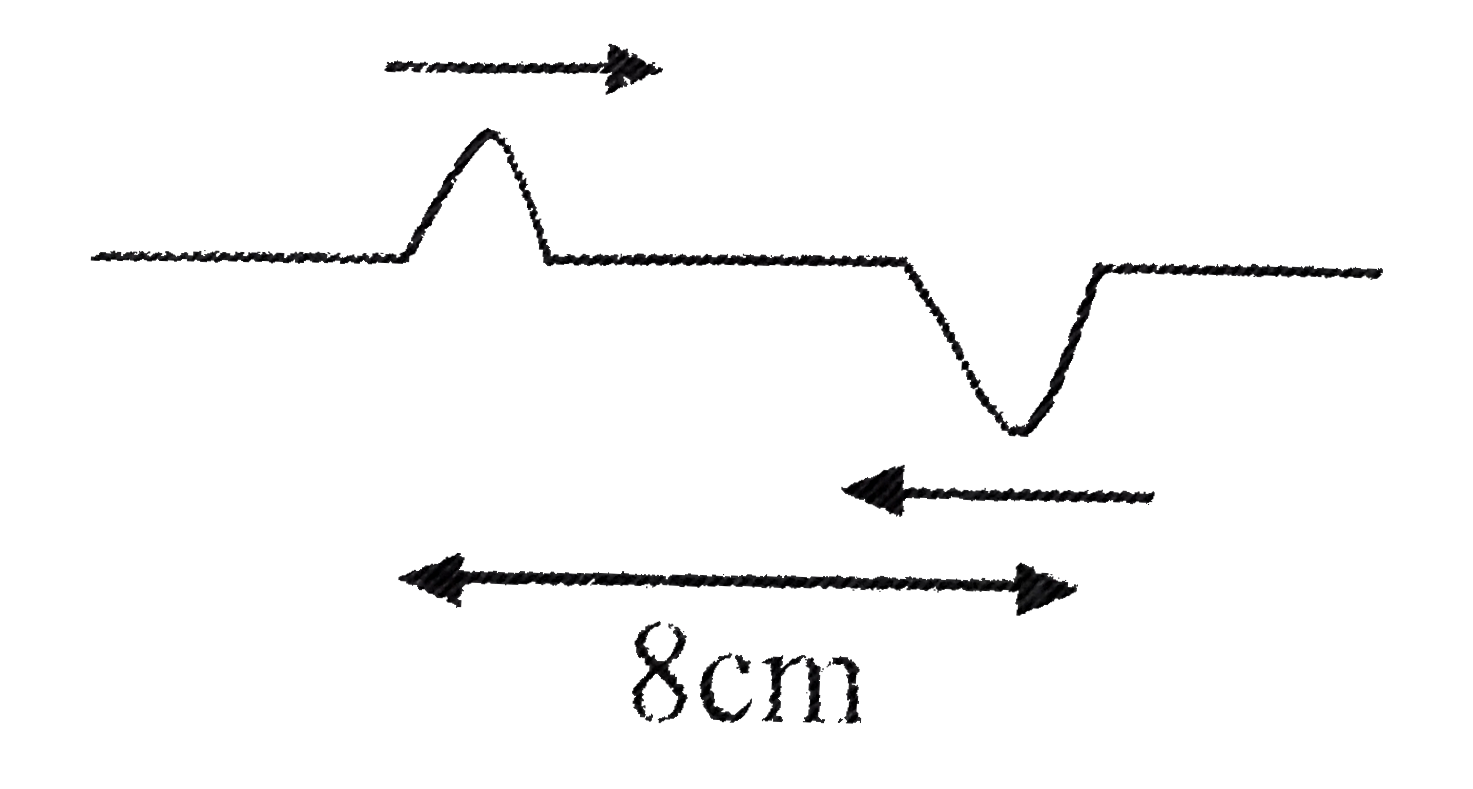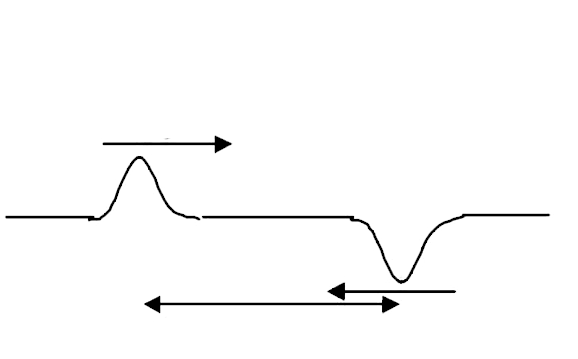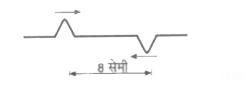Figure shows a rectangular pulse and triangular pulse approaching each other. The pulse speed is 0.5 cm/s. Sketch the resultant pulse at t = 2 s.
In 2 s each pulse will travel a distance of 1 cm.The two pulses overlap between 0 and 1 cm as shown in figure. So A1 and A2 can be added as shown in figure c.
Related Solutions
Figure shows a rectangular pulse and triangular pulse approaching each other. The pulse speed is 0.5 cm/s. Sketch the resultant pulse at t = 2s.
 View Solution
View SolutionThe figure shown at time second, a rectangular and triangular pulse on a uniform wire are approcaching other. The pulse speed is . The resultant pulse at second is
 View Solution
View SolutionThe figure shown at time t = 0 second, a rectangular and triangular pulse on a uniform wire are approcaching other. The pulse speed is 0.5 cm//s . The resultant pulse at t = 2 second is
View SolutionFigure shows a rectangular pulse and a triangular pulse approaching each other along x-axis. The pulse speed is 0.5 cm/s. What is the resultant displacement of medium particles due to superposition of waves at x = 0.5 cm and t = 2 sec.
View SolutionFigure shows a wave pulse at t=0. The pulse moves to the right with a speed of 10cms^-1. Sketch the shape of the string at t=s, 2s and 3s.
 View Solution
View SolutionTwo pulses in a stretched string whose centres are initially 8 cm apart are moving towards each other as shown in the figure. The speed of each pulse is 2 cm/s. After 2 second, the total energy of the pulses will be
 View Solution
View SolutionTwo pulses in a stretched string whose centres are initially 8 cm apart are moving towards each other as shown in the figure. The speed of each pulse is 2 cm/s. After 2 second, the total energy of the pulses will be
View SolutionTwp pulses in a stretched string whose centers are initially 8 cm aprt moving towards each other as shown in fig. The speed of each pulse is 2 cm /s. After 2 seconds, the total energy of the pulses will be :
View SolutionFigure shows a wave pulse at t=0. The pulse moves to the right with a speed of 10cms^-1. Sketch the shape of the string at t=1s, 2s and 3s.
 View Solution
View SolutionFigure shows a wave pulse at t=0. The pulse moves to the right with a speed of 10cms^-1. Sketch the shape of the string at t=1s, 2s and 3s.
 View Solution
View SolutionTwo pulses on a string approach each other at speeds of what is the shape of the string at t=6s?
 View Solution
View SolutionTwo pulses in a stretched string, whose centres are initially 8cm apart, are moving towards each other as shown in the figure. The speed of each pulse is 2cm/s. After 2s the total energy of the pulses will be:
View SolutionTwo pulse in a stretched string whose centers are initially 8cm apart are moving towards each other as shown in the figure. The speed of each pulse is 2cm//s . After 2seconds , the total energy of the pulse will be
View SolutionTwo pulse in a stretched string whose centers are initially apart are moving towards each other as shown in the figure. The speed of each pulse is . After , the total energy of the pulse will be
 View Solution
View SolutionTwo triangular wave pulses are travelling toward each other on a stretched string as shown in Fig . 7.25. Both pulses are identical to each other and travels at . The leading edges of the pulses are apart at . Sketch the shape of the string at .
 View Solution
View SolutionTwo triangular wave pulses are travelling toward each other on a stretched string as shown in Fig . 7.25. Both pulses are identical to each other and travels at 2.00 cm//s . The leading edges of the pulses are 1.00 cm apart at t = 0 . Sketch the shape of the string at t = 0.250 s, t = 0.500 s , t = 0.750 s, t = 1.000 s and t = 1.250 s .
View Solutionदलहन पोधो की जड़ो में ________ जीवाणु की गाँठे रहती है
View Solutionएक खिंची डोरी में उत्पन्न दो स्पन्दों के केन्द्रों के बीच प्रारम्भिक 8 दुरी सेमी है। दोनों स्पन्द चित्रानुसार एक-दूसरे की ओर गति कर रहे है। प्रत्येक स्पन्द की गति 2 सेमी / से है। 2 सेकण्ड के बाद स्पन्दों की कुल ऊर्जा होगी।
 View Solution
View SolutionA triangular pulse moves with a speed to the right. t = 10 x//v After the boundary which is not fixed, the shape of the pulse will be given on it:
View SolutionTwo wave pulses travel in opposite directions on a string and approach each other. The shape of one pulse is inverted with respect to the other
View Solution
